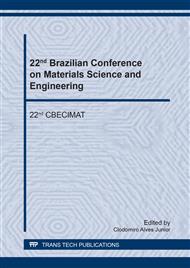p.507
p.513
p.520
p.526
p.535
p.541
p.546
p.552
p.556
Dechroming: An Alternative Treatment for Leather Shavings, to Obtain a Biocompatible Collagen without Environmental Impacts
Abstract:
One of the biggest problems facing the leather industry is the production of solid waste with chromium. Dechroming process remove chrome from leather waste and it is designed to recover the value of collagen in the waste. Thus, the aim of this study was try to improve a methodology of dechroming process already described in the scientific literature, seeking to increase the percentage of dechroming ratio, as well as to evaluate the cytotoxic and genotoxic effects of the dechromed samples obtained from the leather residue for possible applications that require non-toxic materials based on collagens. As results, the dechroming process has been shown to be effective, with 99.29% of chromium removed from the shavings. In addition, it is possible to infer that the process of dechroming performed in this study was efficient in the neutralization step of hexavalent chromium and that the collagen from the leather residue did not shows cytotoxic and genotoxic effects for the evaluated in vitro test system. Therefore, this treatment allows to obtain a valuable product extracted from what was previously a hazardous waste.
Info:
Periodical:
Pages:
535-540
Citation:
Online since:
September 2018
Keywords:
Price:
Сopyright:
© 2018 Trans Tech Publications Ltd. All Rights Reserved
Share:
Citation:


